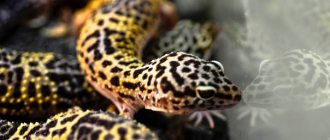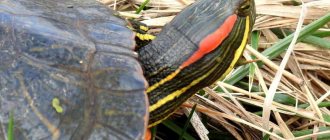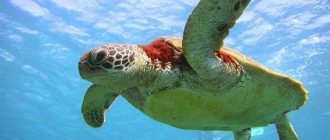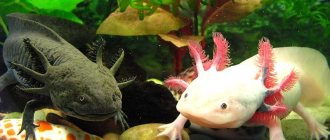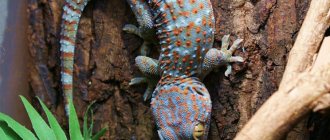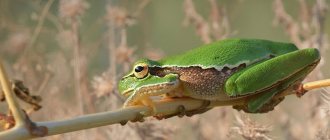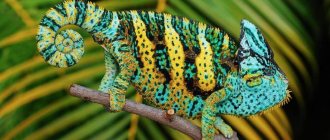Let's talk about what to feed the leopard gecko at home, how best to feed it, at what time of day and how much food to give it?
Feeding time has come.
The spotted leopard gecko is a gourmand, he loves a variety of food, but this does not mean at all that we will spoil him. The situation with food when kept at home in leopard geckos is close to the situation with children in terms of feeding - they will beg for “candy” and then turn their nose up at the full-fledged food necessary for health.
Please do not overfeed your pets; excess fat has never made anyone healthier. The animal must be active, nimble, well-nourished, but not obese! Overfed males mate worse with females and are more passive, and obese females suffer from problems in the reproductive sphere, plus problems with digestion and liver, regardless of gender. In their natural habitats, these geckos feed on a variety of insects and small lizards and rodents.
So, WHAT to feed your leopard gecko?
Natural habitat and color
The animal is small, about 20 cm in length. The body is covered with small scales, on which pimples stand out here and there. The color has many variations (morph): from bright red to violet-olive shades. Morphs are bred through selection, resulting in very interesting variations that attract even experienced terrarium keepers.
These geckos are nocturnal. They live on rocky foothills and semi-fixed sands in northwestern India, Pakistan, southeastern Afghanistan, and eastern Iran.
Wax moth
Pros: *nutritious food. *Ideal for weakened animals. *A tasty treat, many leopard geckos are delighted. *Particularly unpretentious, if the seller gave a little food, then it will live for quite a long time. Cons: *Small, you need a lot to feed an adult leopard gecko, but it is very fatty and it is difficult to find a middle ground. *May cause obesity or liver disease if fed frequently. *Not recommended for freezing.
Equipment for keeping leopard geckos
The minimum terrarium size for one gecko is 30x30x30 cm. However, ideally 45x45x30 cm or more is desirable.
Temperature
The temperature in the terrarium is divided into two zones: the warm third and the cool zone.
During the day, in a warm zone, the temperature should be 30-33 degrees. In the opposite, cold corner - 23-26 degrees. For heating in a terrarium, it is most convenient to use a thermal stone or thermomat. When using a thermomat, the temperature is regulated by a layer of substrate. If you need to increase the temperature in a warm zone, then you need to reduce the layer of sand in the warming zone. At night, temperature changes are desirable, so heating and lighting devices must be turned off.
Substrate and shelters
Leopard geckos love to dig and burrow, so they use natural desert soils, such as Desert Sand or Stone Desert, as a substrate.
Shelters must be installed in the terrarium. They can be made in the form of stone. You can build caves and burrows from special substrates. Additionally, driftwood, stones and decorations are placed along which the reptile can move.
Lighting a terrarium for a leopard gecko
To create natural natural conditions, Reptile Vision or Natural Light lamps are installed as lighting in the terrarium. To stimulate activity and mating games at night, it would not hurt to install a Night Glo night vision lamp.
For night lighting, you can use a Full Moon lamp, which automatically turns on when daylight turns off, helping geckos see in the dark.
Daylight hours in a terrarium are usually 12-14 hours.
Humidity and ventilation
Use the terrarium only with a proven ventilation system that promotes good air exchange and prevents glass fogging.
Humidity in the terrarium is maintained only during the molting period. When the leopard gecko is preparing to molt (the color has lightened and darkened), the sand under the shelter is moistened. Do this every time this period begins. If you use special wet chambers WET ROCK, then there is no need for additional soil moisture.
Leopard geckos drink water by lapping it like a cat from a bowl, so a small drinking bowl should be placed in the terrarium, which is regularly replenished with fresh drinking water.
Naked mice
Pros: *This is an amazing food, perhaps the best in terms of its performance of all the options presented above. *Excellently supports females during laying, quickly puts weakened animals on their feet. *Can be frozen.
Cons: *This food is quite addictive. It is very difficult to later transfer from mice to other KOs. *According to some foreign breeders, constant feeding of naked dogs may cause health problems for leopard geckos.
Feeding the leopard gecko at home
Leopard geckos are insectivores. Their diet at home consists of: locusts, crickets, caterpillars and other insects. Before feeding insects, it is necessary to pollinate with calcium and vitamins. To do this, pour the required amount of insects into a glass, sprinkle them with calcium and vitamins on top, and shake. Feed the pollinated insects to the animal using tweezers or release them into the terrarium.
You can use frozen insects or special Repashy food, such as Grub Pie, as food. They also need to be thawed at room temperature, sprinkled with calcium and vitamins. Grub Pie is prepared according to the instructions, cut into cubes and fed from tweezers.
The amount and frequency of feeding depends on the age of the leopard gecko.
Approximate feeding regimen: 1-6 months - 2-6 crickets every day or every other day. 6-12 months - in two days ~4-8 crickets or 1-3 locusts. 12 months and older - once or twice a week, 5-10 crickets or 2-4 locusts.
Your leopard gecko should always have access to fresh drinking water.
Additionally, you can put a bowl of pure calcium in the leopard gecko’s terrarium, without vitamins and D3. Geckos that need more calcium will readily eat it themselves. This is especially important for young individuals, pregnant and laying females.
If a leopard gecko refuses to eat, what should you do?
First of all, you need to understand whether the reason for refusing to eat is related to any diseases. Assess the condition of the gecko, whether the tail is deflated, whether the consistency of the stool has changed, whether there has been regurgitation of food - these are the cases when you should turn to specialists and contact us for a consultation.
Secondly, you need to check whether the temperature in the terrarium meets the standards. If the conditions and condition of the leopard gecko have not changed, then it’s okay - he just doesn’t want to eat. Skip feeding, reduce the number of insects consumed, increase the intervals.
Adults can refuse food for a long time without losing weight. Such animals can be sent to winter quarters. Often during the breeding season, males and females may refuse to eat, and there is nothing wrong with that.
Cockroaches (any)
Pros: *Not fatty, that is, you can feed as much as you like without worrying that the leopard gecko will overeat. The animal itself will eat as much as it is supposed to. *Incredibly durable, practically unkillable. *Can be frozen for future use.
Cons: *Breed well and live in an apartment, do not allow escapes. *The smell of some species is simply terrible. *Some leopard geckos do not really like it (we assume that it is also due to the specific smell). *Can cause severe allergic reactions in humans. Buy frozen or freeze after purchase.
Reproduction and lifespan of leopard geckos
Reproduction of leopard geckos is a rather interesting process that will require a little preparation. First of all, you need to study color variations, leopard gecko colors - morphs, and select suitable and interesting pairs for breeding.
Secondly, prepare and create conditions for reproduction. Leopard geckos under one and a half years of age should not be allowed into breeding. Females are prepared in advance for the season, fattened, and given special vitamin supplements. Animals should be winterized before boarding.
During the season, females can make from 2 to 8 clutches from one mating. There are 1-2 eggs in a clutch. The eggs are transferred to an incubator, where after a certain period of time small leopard geckos are born. The incubation period directly depends on temperature. At 27 °C it is about two months. Temperature also affects the sex of the offspring. Females hatch at the same 27 °C, and males at 30 °C.
With proper maintenance and care, leopard geckos can live up to 25 years.
Locust
Pros: *Large food, many insects are not required for feeding. *The most nutritious and healthy food for leopard geckos. *There is practically no smell (unless you are breeding locusts). *It is easy to find a fugitive; they do not reproduce autonomously in the apartment. *The most favorite food for leopard geckos, which almost no one refuses. Cons: *Instantly addictive, it is very difficult to switch to any other food after locusts. *Very gentle creatures. They require strict compliance with the conditions of detention. *Requires special food and conditions for breeding (hydroponics). *It is advisable for the locust imago to tear off its wings and paws to avoid unpleasant consequences (with frequent feeding, wings can cause blockage, and the spines from the paws sometimes get stuck in the gums of leopard geckos)
Diseases of leopard geckos
Like any animal, the leopard gecko can get sick. Of course, if all the rules are followed, the risk of disease is minimized. If you suspect any disease, call our store and we will advise you.
- If it is lethargy and lack of appetite, check the temperature in the terrarium.
- If primary signs of rickets appear (soft bones, the gecko squats on its elbows when moving), make sure that the animal receives all the vitamin and mineral supplements in the required doses.
- If you notice remaining pieces of shedding on the body, tail or fingers, they must be removed by first soaking them in warm water.
Water
The terrarium must be kept fresh and clean at all times. Pour into a not-so-small shallow bowl, and you might enjoy watching your leopard gecko lap up the water with its graceful tongue, like a rose petal. Or you will be lucky enough to see how this handsome man takes a bath in the heat. They do this rarely and not all individuals do. But trample in a bowl of water with all your paws, and then with the same paws be sure to get into the calcium - many mischievous people love this. You can spray the walls of the terrarium; some lizards like to lick droplets from the walls.
Communication with a person
Leopard geckos very quickly get used to communicating with people and sit calmly in their arms. In the first week after acquisition, it is worth limiting contact with the animal to allow it to adapt. It is recommended not to disturb young animals without reason.
For taming purposes, it is necessary to feed the leopard geckos from your hands, take them out of the terrarium for a few minutes and hold them in your hands. When the gecko understands that you do not pose a danger, he will stop being afraid of you and will come out on his own. However, this cannot be guaranteed, since each animal has an individual character. If the reptile is not stressed outside the terrarium, you can let it wander around the room after closing the windows and locking other pets in separate rooms. The leopard gecko should only be outside the terrarium under supervision.
On our website there are many photographs of leopard geckos, as well as a video, after watching which you will get acquainted with the habits of the reptile.
The Panteric pet store supplies only healthy animals and helps with the selection of everything needed for terrarium equipment. Our consultants answer ALL questions and give important advice on care and breeding. During your departure, you can leave your pet in our hotel - experienced veterinarians will look after it.
What not to feed
Never feed dead crickets (this does not apply to freezing).
Do not give your pets insects caught on the street, in cottages, etc., they can simply be poisoned by the chemicals that our air and earth are full of, and wild insects can become carriers of diseases. Don't put your pets at risk.
Do not feed moulting (white) crickets; at the moment of molting, they have an empty stomach and will not bring any benefit to the leopard gecko.
Do not feed your leopard geckos fruits, berries, yogurt and similar foods that the leopard gecko does not naturally eat. You won’t eat nails, even though they contain a lot of iron, and iron is good for the blood? )) There is a lot of different advice on the Internet, be rational and let your pets eat what they need.
Priming
It is better to keep the juveniles on plain paper, at least until they are 10-12 cm long.
Leopard geckos are very active when feeding, and can often swallow soil while catching insects.
And in juveniles this leads to digestive problems and even death, since their intestinal lumen is much narrower than that of adults. However, you can feed them in a separate container, as in the video below.
As for sand for adults, opinions are divided: some are quite comfortable keeping geckos in the sand, others say that it is dangerous.
Apparently, the issue is the size of the sand grains; it is important to use very fine sand, 0.5 mm or less. But, if you are still concerned about your health, then pebbles, moss, special mats for reptiles and paper are quite suitable.
Mr. Tail recommends: varieties
According to scientific classification, leopard geckos are currently divided into five species.
Iranian leopard geckos
The natural habitat of this species of Eublephar is Iran, Iraq, Syria, and Türkiye. The lizard prefers rocky mountains from 300 to 1000 meters above sea level. In some places the number of animals is large, in others, for example, in Turkey, it is negligible.
The physique of the Iranian Eublephar is typical for this lizard, but its limbs are much longer and its body is more massive.
The lower part of the body and abdomen are almost white; the back, head and paws on top are covered with brownish-yellowish linear streaks. The long, massive tail has transverse alternating brown and light stripes.
Eublepharis angramainyu is capable of interbreeding with the Spotted Eublepharis and producing healthy, viable hybrids in the first and second generations.
This species feeds mainly on small lizards. Throughout the year it leads a secretive lifestyle, becoming more active only in the spring during the mating season.
This species is not yet protected by the Convention on International Trade, since it has been little studied and its true numbers are unknown.
West Indian leopard gecko
Eublepharis fuscus is a species native to the arid Indian regions in the western part of the country. This is a large lizard up to 40-45 cm long with a bright yellow longitudinal stripe on its back, running over a dark pattern.
This species was first subjected to scientific research at the end of the 19th century, and was found near Bombay, in Mumbai. But for a long time it was considered a subspecies of the spotted leopard gecko and was allocated to a separate class only in 1997.
It differs from other varieties in its large size, location and type of lamellas on the back and legs. The pattern is still more spotted than linear.
It lives in nature at altitudes of 50-650 m in dry forests, preferring hills, boulders and bushes for living. Activity appears in lizards in December, when the young grow a little. There is evidence of a slight decline in population size, although the species still occupies a fairly large area of about 150 thousand square kilometers.
Herdwick's leopard geckos
Eublepharis hardwicki is native to the eastern regions of India and Bangladesh. This species has been studied very little.
It is known that lizards prefer heights from 500 to 1500 m and the population occupies a habitat area of about 400-700 thousand square kilometers. They love dry deciduous forests, living under stones and tree roots.
In terms of beauty of color, it is not much inferior to the Spotted Leopard Gecko, and therefore is the subject of active trade.
The lizard's body is dense and short, maximum 20-23 cm long, the legs are also small.
The length of the nose is equal to the distance between the eyes, the large ear openings are oval. On the head and body there are scales in the form of polyhedra and numerous tubercles. The long tail is slightly rounded and appears swollen.
There are 10 scales above and below the lips, and on the abdomen there are 30 horizontal stripes. They are also present on the lower part of the tail, and the chin is decorated with large shields.
With a long red, thin and flat tongue, Herdvik's Eublefar is able to lick the eyes and the entire head.
The pattern on the lizard's body is in reddish, light or dark brown tones. This is how the head, wide areas on the back and tail are colored. In contrast, yellowish stripes run along the back of the head, the center of the back and the base of the tail. The paws are pinkish in color, and the lower part of the body and abdomen are almost white.
These lizards are silent, but when frightened they make piercing sounds with tints and vibrations.
This is the most widespread species of Eublephar in nature, the population size is large and there is no threat of extinction of the animal. It is found at home, but is not as popular as the leopard print.
Spotted Leopard Gecko
Eublepharis macularius in natural conditions is an inhabitant of Pakistan and northern India. The maximum body length of a night lizard is 25-30 cm.
This is the most common species in home terrariums, as it is easy to maintain and easily reproduces in captivity.
The class was first described in 1854 and has five subspecies.
The main background of the body can be different - straw-yellow or gray-pink, sometimes with a purple tint. But there are always dark “leopard-print” spots scattered throughout it, evenly covering the entire lizard from the nose to the tip of the tail.
Newborns and juveniles have a different color - at first they are almost black, then wide transverse alternating stripes of light (usually yellow) and dark (brown or charcoal) tones appear on the body.
There are sharp tubercles throughout the body and legs; scales are present on the abdomen (20-30), tail, and eyelids (45-57).
Leopard Geckos were first found in the southern parts of Afghanistan, and then in India and Pakistan. These are the indigenous inhabitants of semi-deserts and dry savannas. They love clay and sandy soils, stones, and dried shrubs. The coloring, which looks very bright in terrariums, helps them blend in with nature in their native environment.
During the period when the ambient temperature drops to +5...+15 ºC, Spotted Leopard Geckos fall into a kind of suspended animation, semi-hibernation for several months, waiting out the unfavorable time using fat reserves.
Whereas in summer, when around +40 ºC, lizards are active and feel good. Perhaps the ability to withstand sudden temperature changes without a threat to health made this pet so undemanding in terms of living conditions.
At dusk and at night, Leopard lizards track and attack invertebrates, arthropods, small mammals, scorpions, spiders, and centipedes. These are excellent hunters who know how to get food in difficult conditions due to their keen vision, excellent sense of smell and swift movements.
Now, in addition to natural color variations, there are many breeding ones. It is not a separate species, but only a unique color isomorphic form and the following variety deserves special attention.
Black Leopard Gecko
Natural bright coloring is an excellent camouflage for spotted leopard geckos, but at home they are not threatened by predators and new breeding forms acquire different colors. Today many hybrid forms are known, for example, Black Eye or Black Hole (BH).
The most unique and amazing black color scheme is Black Velvet and Black Pearl. Breeders from Europe are working on obtaining a black spotted lizard. The coal isomorph was obtained as a result of a random mutation when crossing two individuals of the natural color Normal. These are melanistic leopard geckos, which have a familiar pattern on their body, which is very difficult to distinguish due to the black pigment.
The work has been going on for about 20 years, but it has not yet been possible to achieve color stability. Black spotted leopard geckos are in the collections of only leading breeders and the price for such individuals on the foreign market is about 2 thousand dollars.
More often, lizards of lighter gray tones are born, but they are also in great demand; in Russia there is now only one such Eublefar.
This color is also called Black Knight and ranges from dark cinnamon to deep velvety black. The eyes of lizards are grayish with a blue tint.
Usually babies are born lighter and with a normal, clear pattern, but as they grow older they begin to darken and the pattern becomes barely visible. But sometimes it happens exactly the opposite: an absolutely charcoal newborn baby becomes light gray by the time it reaches sexual maturity.
This designer morph has a polygenic type of inheritance, controlled by pairs of non-allelic genes, that is, several combinations of pairs are responsible for the characteristics. There are many breeding varieties with this set: Bandit, Baldy, Carrot head and many others.
In lizards of the albino type Albino, during crossbreeding, a surge of melanin may occur and an absolutely black individual will be born, but this is a very unstable color and the color will not be repeated in the offspring.
Thus, until a clear understanding of the genetic mechanism of the birth of spotted melanists has been obtained, Black Knight Geckos will be an expensive exotic.
Afghan Leopard Gecko
In the official classification they are a subspecies of the Spotted, but some scientists still distinguish it as a separate species. It is found in the southern and northern regions of Afghanistan and in the northern regions of Pakistan. The colors are predominantly golden-yellow; the lizard is small in size - about 20 cm.
Turkmen leopard geckos
Eublepharis turcmenicus were widespread in the southern regions of Turkmenistan and the northern part of Iran, but now they are on the verge of extinction and are listed in the international Red Book.
Lives in rocks and foothills with dry bushes, often choosing burrows abandoned by other animals as shelters. The length of the spotted yellow-brown body rarely reaches 25 cm. The markings are uneven, irregular in shape and with a lilac tint.
It breeds in July-August, clutching two eggs. In all other respects, it is no different from the Spotted Leopard Gecko.
How long can he live without food?
A little hunger is much better than overeating. The lizard's lush tail, which has accumulated a lot of nutrients, will serve as a source of nutrition in the event of even a two-week break in feeding. The reptile's body will feed on reserves from the tail, which will even benefit particularly well-fed individuals.
The tail for a lizard is not only a storage of nutrients, but also a reserve of fat for the winter.
There is nothing complicated or impossible in the rules for feeding spotted leopard geckos. Correct and healthy food, taken according to the regime within acceptable limits, will preserve all the unique external properties, as well as the natural behavioral instincts of these amazing animals. By following all nutritional recommendations, your pet dragon will always be healthy, alert and active.
Have you kept a leopard gecko? Share your secrets of feeding baby dragons with beginners in the comments.
Heating
All reptiles need an environment that allows them to choose places with higher or lower temperatures.
At one moment your leopard geckos will want to warm up, and at another they will want to cool down. The best option for them is bottom heating using a thermal mat.
It should be placed in one corner of the terrarium to create a temperature gradient.
The temperature in the warm corner is about 28-32°C, and if at night it does not drop below 22°C, then the heating can be turned off. Be sure to monitor the temperature using two thermometers located in different corners. Cooling, as well as severe overheating, are fraught with illness.
Heat stones or other heat sources are often sold in pet stores, but should not be purchased. They are not adjustable, you cannot control the temperature, and they can cause burns to your pet.
Lighting
Leopard geckos are usually inactive during the day and do not require heat lamps or UV lamps.
They prefer to hide in a dark shelter during the day and bright light is a source of stress for them. Some owners used bright lamps to cause their geckos to refuse food and die.
Use dim, diffused light and bottom heating. Do not use bright lamps, and use UV lamps only for treatment.
Shelters
They are active at dusk and in nature they hide under stones and snags during the day. So shelters in the terrarium are required. This can be a variety of items: cardboard boxes, pots, branded shelters, coconut halves, whatever.
The main thing is that it is spacious enough. It is better to place several shelters in the terrarium, one in a warm corner, the other in a cool corner.
This way the gecko can choose the temperature it needs. In addition, a so-called wet chamber is needed for molting.
